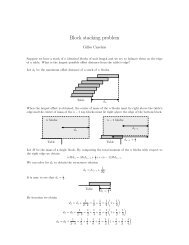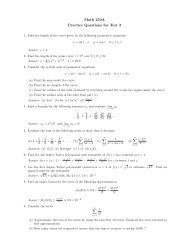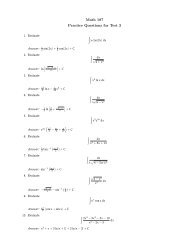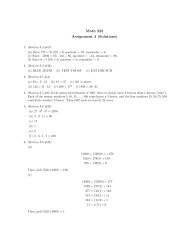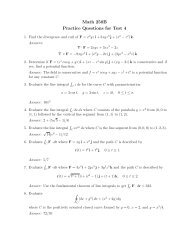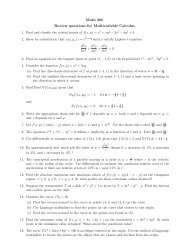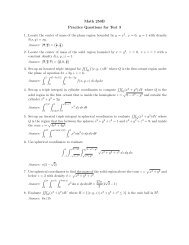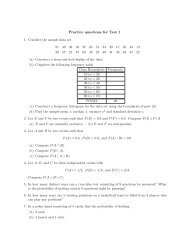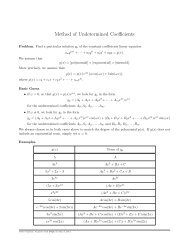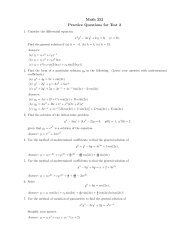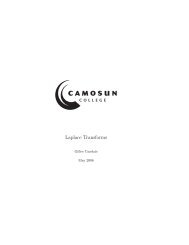Math 222 Assignment 5 (Solutions)
Math 222 Assignment 5 (Solutions)
Math 222 Assignment 5 (Solutions)
Create successful ePaper yourself
Turn your PDF publications into a flip-book with our unique Google optimized e-Paper software.
<strong>Math</strong> <strong>222</strong><br />
<strong>Assignment</strong> 5 (<strong>Solutions</strong>)<br />
1. (Section 4.1 #6) Let<br />
P (n) : 1 · 1! + 2 · 2! + 3 · 3! + · · · + n · n! = (n + 1)! − 1.<br />
We see that P (1) : 1 · 1! = (1 + 1)! − 1 = 1 is true. Now, assume that P (k) is true for a fixed<br />
k ∈ {1, 2, 3, . . . }, then<br />
1 · 1! + 2 · 2! + · · · + k · k! + (k + 1) · (k + 1)! = (k + 1)! − 1 + (k + 1) · (k + 1)!<br />
= (k + 1)!(k + 1 + 1) − 1<br />
= (k + 1)!(k + 2) − 1<br />
= (k + 2)! − 1<br />
= ((k + 1) + 1)! − 1<br />
Therefore P (k) → P (k + 1) is true. By mathematical induction, we then conclude that P (n)<br />
is true for all n = 1, 2, 3, . . . .<br />
2. (Section 4.1 #20) Let P (n) : 3 n < n!. We want to shaw that P (n) is true for all integers<br />
n > 6. We see that P (7) is true since 3 7 = 2187 < 7! = 5040. Let’s assume that P (k) is true<br />
for a fixed k > 6. Then<br />
3 k+1 = 3 · 3 k<br />
< 3 · k!<br />
< (k + 1)k! (Since 3 < k + 1)<br />
= (k + 1)!.<br />
Therefore P (k) → P (k + 1) is true. By mathematical induction, we then conclude that P (n)<br />
is true for all integers n > 6.<br />
3. (Section 4.1 #34) Let P (n) : n 3 − n is divisible by 6. P (1) is clearly true since 1 3 − 1 = 0 is<br />
divisble by 6. Let’s assume that P (k) is true for a fixed k ∈ {1, 2, 3, . . . }, i.e., k 3 − k is divisble<br />
by 6. Then<br />
(k + 1) 3 − (k + 1) = (k 3 + 3k 2 + 3k + 1) − (k + 1)<br />
= (k 3 − k) + (3k 2 + 3k)<br />
= (k 3 − k) + 3k(k + 1)<br />
Since either k or k + 1 is even, we conclude that 3k(k + 1) is divsible by 6.<br />
(k + 1) 3 − (k + 1) is divisible by 6.<br />
Therefore,<br />
By mathematical induction, we then conclude that P (n) is true for all n = 1, 2, 3, . . . .
<strong>Math</strong> <strong>222</strong> <strong>Assignment</strong> 5 (<strong>Solutions</strong>) Page 2 of 3<br />
4. (Section 4.3 #4)<br />
(a)<br />
f(2) = f(1) − f(0) = 1 − 1 = 0<br />
f(3) = f(2) − f(1) = 0 − 1 = −1<br />
f(4) = f(3) − f(2) = −1 − 0 = −1<br />
f(5) = f(4) − f(3) = −1 − (−1) = 0<br />
(b)<br />
f(2) = f(1)f(0) = 1(1) = 1<br />
f(3) = f(2)f(1) = 1(1) = 1<br />
f(4) = f(3)f(2) = 1(1) = 1<br />
f(5) = f(4)f(3) = 1(1) = 1<br />
(c)<br />
f(2) = f(1) 2 + f(0) 3 = 1 + 1 = 2<br />
f(3) = f(2) 2 + f(1) 3 = 2 2 + 1 = 5<br />
f(4) = f(3) 2 + f(2) 3 = 5 2 + 2 3 = 33<br />
f(5) = f(4) 2 + f(3) 3 = 29 2 + 5 3 = 1214<br />
(d)<br />
f(2) = f(1)/f(0) = 1/1 = 1<br />
f(3) = f(2)/f(1) = 1/1 = 1<br />
f(4) = f(3)/f(2) = 1/1 = 1<br />
f(5) = f(4)/f(3) = 1/1 = 1<br />
5. (Section 4.3 #8)<br />
(a) a n+1 = a n + 4, a 1 = 2<br />
(b) a n+1 = 2 − a n , a 1 = 0<br />
(c) a n+1 = a n + 2(n + 1), a 1 = 2<br />
(d) a n+1 = a n + 2n + 1, a 1 = 1<br />
6. (Section 4.3 #18) Let<br />
P (n) :<br />
[ ] n [ ]<br />
1 1 Fn+1 F<br />
=<br />
n<br />
.<br />
1 0 F n F n−1
<strong>Math</strong> <strong>222</strong> <strong>Assignment</strong> 5 (<strong>Solutions</strong>) Page 3 of 3<br />
The base case P (1) is clearly true since<br />
where F 2 = F 1 + F 0 = 1 + 0 = 1.<br />
[ ] 1 [ ]<br />
1 1 F2 F<br />
= 1<br />
=<br />
1 0 F 1 F 0<br />
[ ] 1 1<br />
1 0<br />
Let’s assume that P (k) is true for a fixed k ∈ {1, 2, 3, . . . }, then<br />
[ ] k+1 1 1<br />
=<br />
1 0<br />
as desired.<br />
[ 1 1<br />
1 0<br />
7. (Section 4.3 #25)<br />
] [ ] k 1 1<br />
=<br />
1 0<br />
[ ] [ ] [ ] [ ]<br />
1 1 Fk+1 F k Fk+1 + F<br />
=<br />
k F k + F k−1 Fk+2 F<br />
=<br />
k+1<br />
,<br />
1 0 F k F k−1 F k+1 F k F k+1 F k<br />
(a) (i) 0 ∈ S, (ii) if x ∈ S, then x + 2 ∈ S, (iii) if x ∈ S, then x − 2 ∈ S.<br />
(b) (i) 2 ∈ S, (ii) if x ∈ S, then x + 3 ∈ S.<br />
(c) (i) 1 ∈ S, (ii) 2 ∈ S, (iii) 3 ∈ S, (iv) 4 ∈ S, (v) if x ∈ S, then x + 5 ∈ S.<br />
8. (Section 5.1 #16) There are 26 4 strings of 4 lowercase letters. There are 25 4 strings without<br />
an x. Then, there are 26 4 − 25 4 = 66351 strings with an x.<br />
9. (Section 5.1 #24)<br />
(a) 10 · 9 · 8 · 7 = 5040.<br />
(b) 10 · 10 · 10 · 5 = 5000.<br />
(c) There are 4 ways to choose the position of the digit different than 9 and there are 9 ways<br />
to choose the digit. The answer is then 4 · 9 = 36.<br />
10. (Section 5.1 #42) There are 2 5 bit strings of length seven that starts with two 0s. There are 2 4<br />
strings that end with three 1s. There are 2 2 string that starts with two 0s and end with three<br />
1s. Therefore there are 2 4 + 2 5 − 2 2 = 44 strings that starts with two 0s or end with three 1s.



